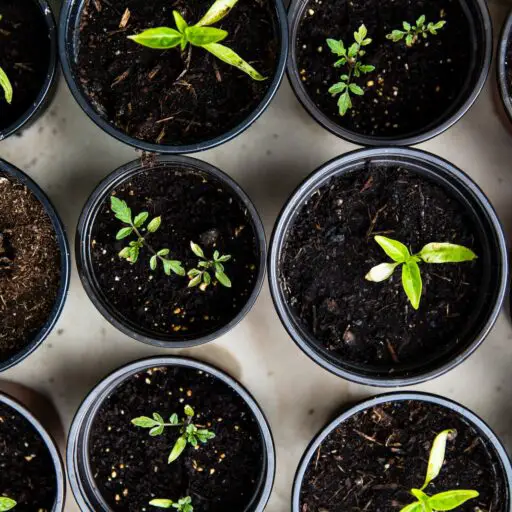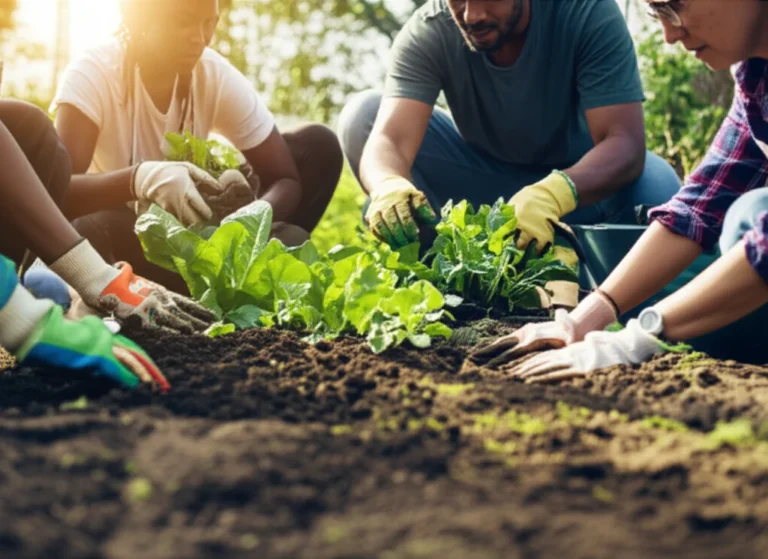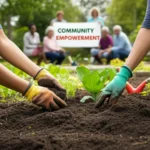Support our educational content for free when you purchase through links on our site. Learn more
Imagine turning a vacant urban lot into a thriving oasis where neighbors grow fresh veggies, share stories, and boost their wellbeing. Sounds like a dream, right? Well, community gardens make this dream a reality—and the benefits go far beyond just pretty plants. From improving mental health to fighting food insecurity, these green spaces are transforming neighborhoods across the globe.
In this article, we’ll uncover the 5 powerful benefits of community gardens that you might not have expected. Plus, we’ll share expert tips on the best crops to grow, how to start your own garden, and inspiring success stories that prove community gardening is more than just a hobby—it’s a movement. Ready to dig in and discover why these gardens are a win for everyone? Let’s grow together!
Key Takeaways
- Community gardens boost local food security by providing fresh, affordable produce in urban food deserts.
- They enhance mental health and wellbeing through physical activity, stress relief, and connection to nature.
- These gardens strengthen social bonds, creating vibrant, supportive communities.
- Community gardens promote environmental sustainability by improving biodiversity and reducing waste.
- They offer educational opportunities for all ages, teaching valuable skills and fostering stewardship.
Ready to start your own garden or upgrade your tools? Check out these essentials:
- Gardening Tools: Fiskars Garden Tool Set on Amazon | Walmart
- Organic Seeds: Burpee Organic Seeds on Amazon | Burpee Official Website
- Composting Supplies: Envirocycle Compost Tumbler on Amazon | Envirocycle Official Website
Table of Contents
- ⚡️ Quick Tips and Facts About Community Gardens
- 🌱 Growing Together: The Roots and Rise of Community Gardens
- 🌿 What Is a Community Garden? Defining the Green Space
- 🥕 5 Amazing Benefits of a Community Garden You Can’t Ignore
- 🌾 Best Crops to Grow in Your Community Garden for Maximum Impact
- 🏥 Public Health Benefits: How Community Gardens Improve Wellbeing
- 🌍 Cultivating Change: Using Community Gardens to Promote Social and Environmental Justice
- 🛠️ How to Start and Sustain a Thriving Community Garden: Expert Tips
- 💡 Innovative Community Garden Models and Success Stories
- 🌟 Quick Wins: Easy Ways to Maximize Your Community Garden’s Benefits
- 📚 Conclusion: Why Community Gardens Are a Win for Everyone
- 🔗 Recommended Links for Community Garden Enthusiasts
- ❓ FAQ: Your Burning Questions About Community Gardens Answered
- 📖 Reference Links and Further Reading
⚡️ Quick Tips and Facts About Community Gardens
Welcome to the green heart of community gardening! Before we dig deep into the 5 benefits of a community garden, here are some quick nuggets from our seasoned gardeners at Community Gardening™ to get your hands itching for soil:
- ✅ Community gardens increase access to fresh, affordable produce, especially in urban food deserts.
- ✅ They transform vacant lots into vibrant, eco-friendly spaces that boost neighborhood aesthetics and biodiversity.
- ✅ Gardening together strengthens social bonds and builds a sense of ownership among neighbors.
- ✅ These gardens serve as living classrooms, teaching kids and adults alike about sustainability, nutrition, and horticulture.
- ✅ Studies show community gardens improve mental health by reducing stress and promoting physical activity.
Did you know? There are over 18,000 community gardens across the US and Canada, each one a little oasis of hope and health! 🌿
For a quick primer on the purpose and surprising benefits of community gardens, check out our related article: What Is the Purpose of a Community Garden? 10 Surprising Benefits 🌿.
🌱 Growing Together: The Roots and Rise of Community Gardens
Community gardens aren’t a new fad—they’re a time-tested tradition that’s blossomed worldwide. From the Victory Gardens of WWII to modern urban farms, these shared spaces have always been about growing food and community simultaneously.
- Historical Tidbit: During WWII, Victory Gardens supplied nearly 40% of the US’s fresh vegetables. Today, community gardens echo that spirit by addressing modern challenges like urban food deserts and social isolation.
- Modern Movement: Cities like New York, Chicago, and Toronto have embraced community gardens as tools for urban renewal and sustainability. The American Community Gardening Association reports a steady rise in gardens since the 1970s, proving that green thumbs are here to stay!
Our own experience at Community Gardening™ shows that these gardens are more than just plots of land—they’re living symbols of resilience and cooperation.
🌿 What Is a Community Garden? Defining the Green Space
If you’re wondering, “What exactly is a community garden?”—you’re not alone! At its core, a community garden is:
- A shared outdoor space where individuals or groups cultivate fruits, vegetables, herbs, and flowers.
- Often located on vacant lots, rooftops, or public parks.
- Managed collectively, with members sharing responsibilities like planting, watering, and harvesting.
- A hub for education, socializing, and environmental stewardship.
Community gardens vary widely—from allotment-style plots to communal beds—but all share the goal of bringing people together through gardening.
Want to see community gardens in action? Check out the featured video for a quick visual tour!
🥕 5 Amazing Benefits of a Community Garden You Can’t Ignore
Ready to get to the juicy part? Here are the top 5 benefits of community gardens, backed by research and our own dirt-under-the-nails experience.
1. Boosting Local Food Security and Access to Fresh Produce
One of the most celebrated perks of community gardens is their role in fighting food insecurity. According to Tulane University’s Public Health blog, community gardens provide fresh fruits and veggies in areas where grocery stores are scarce or expensive.
- Why it matters:
- Fresh produce is often unaffordable or unavailable in urban “food deserts.”
- Community gardens reduce reliance on processed foods, improving nutrition.
- Growing your own food cuts down on transportation emissions—a win for the planet!
Our story: At Community Gardening™, we’ve seen families transform their diets by harvesting kale, tomatoes, and berries right from their neighborhood plots. It’s like having a mini farmers’ market just steps away!
2. Enhancing Mental Health and Wellbeing Through Gardening
Gardening isn’t just good for your body—it’s a balm for the soul. Studies show that digging in the dirt reduces cortisol levels (the stress hormone) and boosts serotonin.
- Benefits include:
- Stress relief and mood improvement.
- Increased physical activity and vitamin D exposure.
- Opportunities for mindfulness and connection with nature.
Our gardeners often tell us, “I come here to escape the noise and find peace.” It’s no surprise that community gardens are becoming recognized as therapeutic landscapes.
3. Strengthening Community Bonds and Social Connections
Community gardens are social glue. They bring together people from diverse backgrounds to share knowledge, labor, and harvests.
- How it works:
- Shared tasks like planting and weeding foster teamwork.
- Garden events and potlucks build friendships.
- Garden shares help those who can’t participate actively still benefit.
As Wellpoint Care Network puts it, “Those who choose to plant feel personally invested in where they live.” We’ve witnessed neighbors become lifelong friends over a shared tomato plant!
4. Promoting Environmental Sustainability and Biodiversity
Community gardens are mini-ecosystems that support pollinators, improve soil health, and reduce urban heat islands.
- Eco-friendly perks:
- Composting reduces waste and enriches soil.
- Avoidance of pesticides creates safer habitats for bees and butterflies.
- Green spaces improve air quality and reduce stormwater runoff.
Our team loves using organic methods and native plants to boost biodiversity. It’s like creating a tiny nature reserve right in the city!
5. Providing Educational Opportunities for All Ages
From toddlers to seniors, community gardens are classrooms without walls.
- Learning highlights:
- Hands-on lessons in biology, nutrition, and ecology.
- Skill-building in responsibility, patience, and teamwork.
- Mentorship opportunities connecting generations.
We’ve hosted workshops on everything from seed saving to composting, and the enthusiasm is contagious. Gardening truly is a lifelong teacher!
🌾 Best Crops to Grow in Your Community Garden for Maximum Impact
Choosing what to grow can be overwhelming. Here’s a handy table of top-performing crops that thrive in community gardens, especially in moderate climates like ours:
| Crop | Benefits | Growing Tips | Harvest Time |
|---|---|---|---|
| Kale | Nutrient-dense, hardy | Prefers cool weather, regular watering | 55-75 days |
| Tomatoes | Popular, versatile | Needs full sun, staking support | 60-85 days |
| Strawberries | Sweet, perennial | Well-drained soil, mulch to protect | Late spring/summer |
| Radishes | Fast-growing, space-efficient | Sow in cool weather, thin seedlings | 20-30 days |
| Snow Peas | Nitrogen-fixing, edible pods | Trellis support, cool weather | 60 days |
For more crop ideas and planting schedules, explore our Edible Plants category.
🏥 Public Health Benefits: How Community Gardens Improve Wellbeing
Community gardens are more than just green spaces—they’re public health champions. Here’s how:
- Nutrition: Access to fresh produce combats diet-related diseases like diabetes and hypertension.
- Physical Activity: Gardening provides moderate exercise, improving cardiovascular health.
- Mental Health: Nature exposure reduces anxiety and depression symptoms.
- Social Inclusion: Gardens reduce loneliness and promote social support networks.
The Tulane Public Health article highlights these benefits, noting that gardens are especially valuable in underserved communities.
🌍 Cultivating Change: Using Community Gardens to Promote Social and Environmental Justice
Community gardens are powerful tools for equity and empowerment:
- Addressing Food Deserts: They provide fresh food where supermarkets are scarce.
- Empowering Marginalized Groups: Gardens offer leadership and economic opportunities.
- Environmental Justice: Green spaces improve air quality and reduce urban heat in low-income neighborhoods.
- Cultural Preservation: Gardens can celebrate heritage crops and traditions.
At Community Gardening™, we’ve partnered with local nonprofits to launch gardens in underserved areas, witnessing firsthand how these spaces uplift communities.
🛠️ How to Start and Sustain a Thriving Community Garden: Expert Tips
Thinking of starting your own community garden? Here’s a step-by-step guide from our team:
- Find a Suitable Location: Look for accessible, sunny spots with good soil or potential for raised beds.
- Engage the Community: Host meetings to gather interest and input.
- Secure Permissions: Work with local authorities or landowners for permits.
- Plan the Layout: Decide on plot sizes, communal areas, and pathways.
- Gather Resources: Tools, seeds, compost, and water access are essentials.
- Set Rules and Roles: Establish guidelines for maintenance, sharing, and conflict resolution.
- Launch with a Planting Event: Celebrate with a kickoff party to build momentum.
- Maintain and Evolve: Regular meetings and events keep the garden vibrant and inclusive.
For detailed policies and design ideas, visit our Community Garden Policies and Garden Design Ideas pages.
💡 Innovative Community Garden Models and Success Stories
Community gardens come in all shapes and sizes. Here are some inspiring models:
- Allotment Gardens: Individual plots rented or assigned to members.
- Communal Gardens: Shared beds where everyone contributes and harvests collectively.
- Therapeutic Gardens: Designed for healing and rehabilitation in hospitals or senior centers.
- School Gardens: Educational spaces integrated into curricula.
One standout success is the Victory Garden Initiative in Milwaukee, which transformed vacant lots into thriving food hubs, improving nutrition and community pride. Learn more about their work through local partners like Groundwork Milwaukee.
🌟 Quick Wins: Easy Ways to Maximize Your Community Garden’s Benefits
Want to supercharge your garden’s impact? Try these quick tips:
- Start Composting: Turn kitchen scraps into black gold for your soil.
- Host Garden Days: Invite neighbors for planting or harvest parties.
- Incorporate Pollinator Plants: Attract bees and butterflies with native flowers.
- Create a Tool Library: Share tools to reduce costs and clutter.
- Offer Workshops: Teach skills like seed starting or pest management.
These small steps can make a big difference in community engagement and garden productivity!
📚 Conclusion: Why Community Gardens Are a Win for Everyone
So, what’s the final verdict on community gardens? After digging through facts, stories, and our own hands-in-the-dirt experience at Community Gardening™, we can confidently say: community gardens are a powerhouse of benefits that nourish not just plants, but people and places alike.
From boosting local food security and improving mental health to fostering social bonds and promoting environmental stewardship, these green spaces are more than just gardens—they’re catalysts for positive change. Whether you’re a seasoned gardener or a curious newbie, joining or starting a community garden can be a transformative journey.
Remember the question we teased earlier—how exactly do these gardens knit communities together while feeding bodies and souls? The answer lies in the shared effort, learning, and joy that blossoms alongside the crops. It’s a beautiful cycle of growth that keeps on giving.
Ready to get your hands dirty and your community thriving? Let’s grow together! 🌱
🔗 Recommended Links for Community Garden Enthusiasts
Looking to gear up or deepen your gardening knowledge? Here are some top picks from our toolkit and bookshelf:
-
Gardening Tools & Supplies:
-
Books for Community Gardeners:
- The Community Gardening Handbook by Ben Raskin — Amazon Link
- All New Square Foot Gardening by Mel Bartholomew — Amazon Link
- The Urban Farmer by Curtis Stone — Amazon Link
-
Composting Supplies:
Happy gardening and growing! 🌻
❓ FAQ: Your Burning Questions About Community Gardens Answered
What are the social benefits of community gardening?
Community gardens act as social hubs where people from diverse backgrounds come together. They foster friendships, cooperation, and a sense of belonging. Shared responsibilities like planting and harvesting create teamwork and mutual support, reducing social isolation. Events and workshops further enhance community engagement, making neighborhoods stronger and more connected.
How does community gardening improve mental health?
Gardening reduces stress by encouraging mindfulness and providing a calming connection to nature. Physical activity involved in gardening releases endorphins, improving mood and reducing anxiety. Exposure to sunlight boosts vitamin D, which is linked to better mental health. Community gardens also offer social interaction, which combats loneliness and depression.
Can community gardens help reduce food insecurity?
Absolutely! By providing access to fresh, affordable produce, community gardens directly combat food deserts—areas lacking grocery stores with healthy options. They empower individuals to grow their own food, improving nutrition and reducing dependence on processed foods. Gardens also often donate surplus harvests to food banks and shelters.
What environmental advantages do community gardens offer?
Community gardens contribute to urban greening, which improves air quality, reduces heat islands, and manages stormwater runoff. They promote organic practices like composting and pesticide avoidance, which protect soil and water health. Gardens also serve as habitats for pollinators and beneficial insects, supporting local ecosystems.
How do community gardens promote local biodiversity?
By planting a variety of fruits, vegetables, herbs, and native flowers, community gardens create diverse habitats that attract bees, butterflies, birds, and soil microbes. This diversity strengthens ecosystem resilience and supports pollination, which benefits both the garden and surrounding natural areas.
In what ways do community gardens strengthen neighborhood connections?
Gardens provide a shared space where neighbors collaborate, share knowledge, and celebrate together. This fosters trust and mutual respect, often leading to broader community initiatives. Garden shares and communal activities ensure inclusivity, allowing even those unable to garden actively to participate and benefit.
What skills can individuals learn from participating in community gardening?
Participants gain practical skills like soil preparation, planting, pest management, and composting. They also develop soft skills such as teamwork, patience, responsibility, and leadership. Educational programs often teach nutrition, environmental stewardship, and cultural heritage through gardening practices.
How can community gardens support youth development?
Youth involvement in community gardens teaches responsibility, healthy eating habits, and environmental awareness. Hands-on experiences improve motor skills and foster a sense of accomplishment, which can boost self-esteem and academic engagement.
What challenges might community gardens face, and how can they be overcome?
Common challenges include securing land tenure, funding, and volunteer engagement. Solutions involve building strong community partnerships, applying for grants, and creating inclusive governance structures. Regular communication and celebrating successes help maintain momentum.
📖 Reference Links and Further Reading
- Tulane University Public Health: 5 Benefits of Community Gardens
- Wellpoint Care Network: 10 Benefits of a Community Garden
- American Community Gardening Association: Community Gardening Resources
- Victory Garden Initiative: Milwaukee Community Gardens
- Public Health Seattle & King County: 4 Benefits of Community Gardens
- Burpee Seeds: Official Website
- Fiskars Tools: Official Website
- Envirocycle Composting: Official Website
For more on the benefits of community gardens, visit our Benefits of Community Gardens category.
Happy gardening and growing together! 🌻🌿





